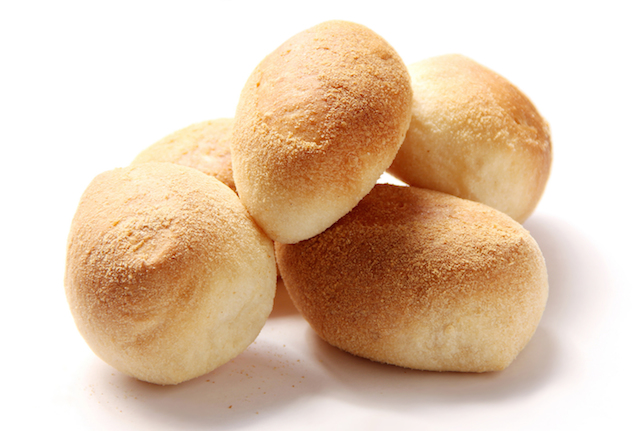
Pandesal photo via Shutterstock
By Amalissa Uytingco
My ultimate comfort food comes in the form of pandesal, a traditional Filipino bread roll often eaten for breakfast with coco jam or butter. Coming home from school to the intoxicating scent of freshly baked pandesal is one of the highlights of my childhood.
I remember kicking off my shoes and haphazardly tossing aside my backpack as I made a beeline for the kitchen where my grandpa stood, tending to a batch of bread. Peering over his shoulder I saw golden-brown, palm-sized rolls sitting side-by-side in compact rows atop the baking sheet. I couldn’t help but to snatch one up before it fully cooled, tossing it from hand to hand as the sudden heat scalded my fingers. I remember breaking the roll in half and it being soft to the touch—fluffy and pillowy. Biting into it revealed a tender crumb that melted into a sweet, buttery dollop on the tongue.
My grandfather lives across the country from me now, but having this recipe allows me savor a little piece of him whenever I’m feeling particularly nostalgic.
Ingredients:
*Note: this recipe makes pandesal IN BULK, upwards of three-dozen rolls depending on size
Fermentation: mix the following ingredients together well and let sit for 30 minutes in a warm (not exceeding 110 degrees) place
1 packet dry active yeast
1 tbsp sugar
½ cup lukewarm water
½ cup unbleached bread flour
4 cups of flour (my grandpa mixes half bread flour and half white, whole wheat or all-purpose)
¾ cup sugar
¾ tbsp salt
6 tbsp (¾ stick) unsalted butter, melted
1 cup buttermilk at room temperature
4 egg yolks
Directions:
- In a large bowl combine the sugar, buttermilk, melted butter, salt, and eggs.
- Stir together well with a wooden spoon then add in the fermented ingredients.
- Slowly incorporate the flour—when a dough starts to form, forgo the spoon and use your hands to knead (the dough will be sticky, so lightly oil your hands to avoid sticking).
- When the dough becomes smooth, cover the bowl and place into a warm space to let rise for 30 minutes.
- After 30 minutes, do a second kneading—at this point the dough should be smooth, but if not, my grandfather has done a third kneading as well.
- After the second kneading let the dough rise for another 30 minutes.
- When the rising is done, punch the dough down and form it into a long roll/log.
- Divide the dough into 2.5-3oz balls and arrange on a lightly greased baking pan.
- Let rise for two hours or until the balls are double in size.
- When almost ready to bake, preheat the oven to 325 degrees.
If you have a convection oven, bake the rolls for about 26 minutes until golden brown on top. If you do NOT have a convection oven, bake the rolls for about 13 minutes on the top rack before transferring them onto the bottom rack for another 13 minutes.
 About the Writer
About the Writer


